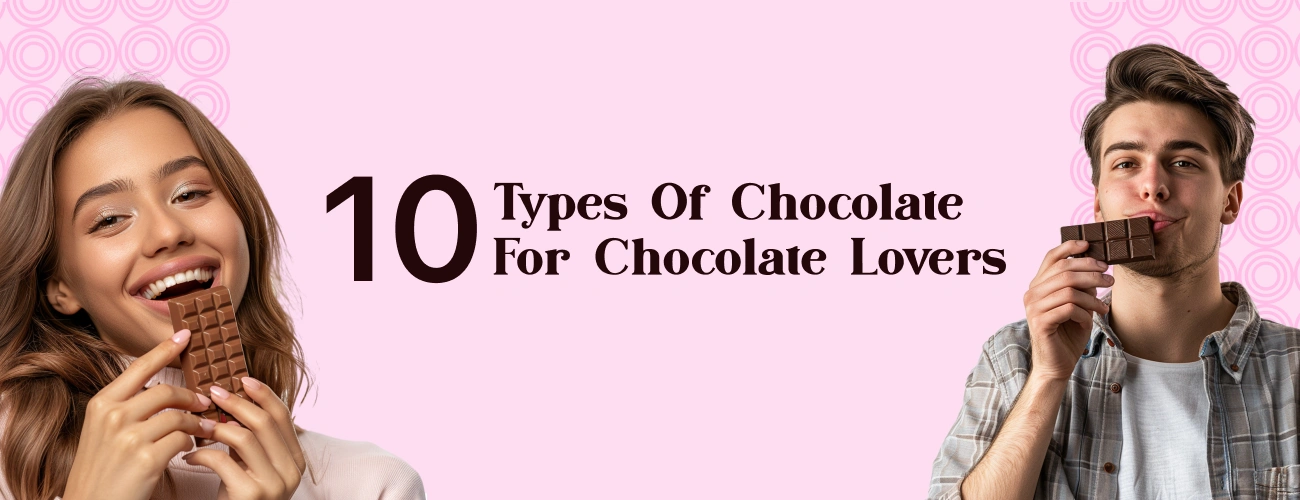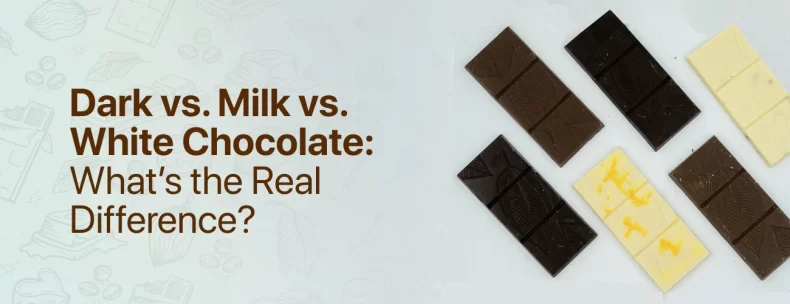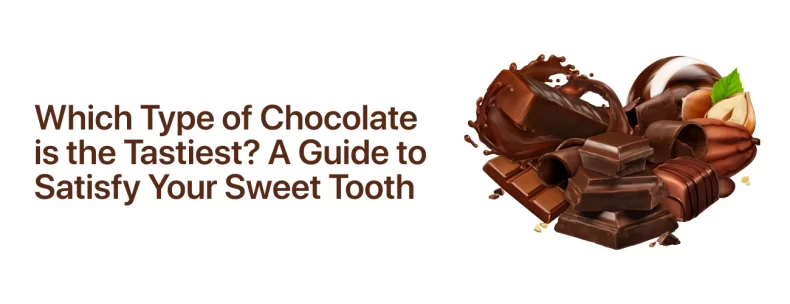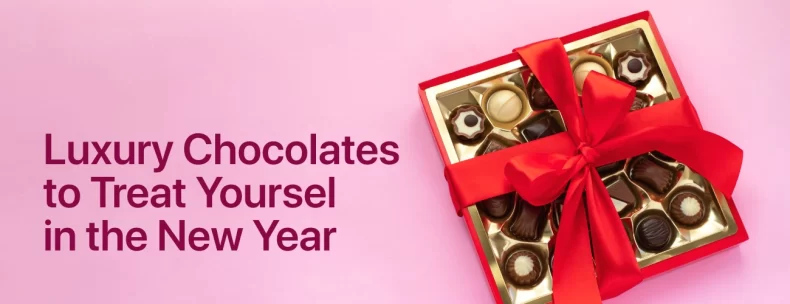
10 Types of Chocolate for Chocolate Lovers
Introduction
Chocolate is a universal delight that has transcended cultures and traditions, becoming a beloved treat for people of all ages. From the creamy sweetness of milk chocolate to the rich, intense flavors of dark chocolate, there are countless variations to explore. Whether you’re a chocolate connoisseur or simply someone who enjoys a sweet indulgence now and then, the variety of chocolates available can seem endless. In this blog, we’ll explore 10 distinct types of chocolate that every chocolate lover should know about.
Dark Chocolate: The Rich and Bold Classic
Dark chocolate is often considered the purest form of chocolate. It contains a higher percentage of cocoa, making it rich, intense, and less sweet compared to other types. Typically, dark chocolate contains at least 50% cocoa, with some high-end varieties containing as much as 85% or more.
Flavors: The taste of Dark Chocolate varies depending on the percentage of cocoa. At lower percentages (50%-60%), it may be mildly bitter, with a noticeable sweetness. Higher percentages (70%-85%) have an intense, slightly bitter flavor, with subtle earthy and fruity undertones.
Best For: Dark chocolate is ideal for those who love a more sophisticated, less sugary chocolate experience. It pairs wonderfully with wines, cheeses, and even some fruits like raspberries or oranges.
Milk Chocolate: Sweet and Creamy
Milk Chocolate is the most popular type of chocolate, known for its creamy, sweet flavor. It’s made with cocoa solids, cocoa butter, sugar, and milk powder, giving it a smooth and rich taste that many people adore. The milk adds a layer of sweetness and creaminess, making it less intense than dark chocolate.
Flavors: Milk chocolate’s flavor profile is sweet and smooth with hints of caramel and vanilla. It’s perfect for those who prefer chocolate that isn’t as bitter as dark chocolate but still rich and satisfying.
Best For: Milk chocolate is great for snacking, baking, or as a topping for ice cream. It’s the go-to choice for children and those with a sweet tooth, offering a comforting, familiar taste.
White Chocolate: The Creamy Delight
White Chocolate is distinct because it doesn’t contain cocoa solids, which are the key component responsible for chocolate’s characteristic color and flavor. Instead, it’s made with cocoa butter, sugar, and milk solids, resulting in a creamy, buttery taste.
Flavors: White chocolate is sweet and creamy, with a smooth texture that melts effortlessly in your mouth. While it lacks the rich flavor of dark or milk chocolate, it’s a perfect balance of sweetness and creaminess.
Best For: White chocolate is often used in desserts and confections like truffles, cookies, or mousse. It pairs wonderfully with berries and citrus fruits, and it’s also a favorite for making creamy hot chocolate or in the creation of decorative chocolate pieces.
Ruby Chocolate: The New Trend
Ruby chocolate is a relatively new type of chocolate that was introduced in 2017 by the Swiss chocolate manufacturer Barry Callebaut. It’s made from specially processed cocoa beans, giving it a natural pinkish-red color without the need for artificial coloring.
Flavors: Ruby chocolate has a unique, slightly tangy flavor with fruity undertones. It combines the sweetness of milk chocolate with a tartness that makes it stand out from the crowd. Its taste is refreshing, vibrant, and playful, making it a favorite among those looking for something new.
Best For: Ruby chocolate is perfect for those who enjoy something a little different. It works well in chocolate bars, truffles, and even in gourmet desserts. Its beautiful color also makes it an excellent choice for decorative chocolate work.
Semi-Sweet Chocolate: The Versatile Favorite
Semi-sweet chocolate contains a good balance of cocoa solids and sugar, usually with a cocoa content between 40% and 60%. This type of chocolate is most commonly found in chocolate chips and baking recipes.
Flavors: Semi-sweet chocolate strikes a perfect balance between the bitterness of dark chocolate and the sweetness of milk chocolate. It’s not too bitter, yet not overly sweet, making it an excellent choice for baking and desserts.
Best For: Semi-sweet chocolate is a baker’s favorite. It’s commonly used in cookies, brownies, and cakes. It also makes an excellent addition to chocolate fondues or as a topping for fruit like strawberries or bananas.
Bittersweet Chocolate: Deep and Intense
Bittersweet chocolate is similar to dark chocolate but contains slightly more sugar, making it less bitter. It typically contains around 60% to 80% cocoa solids, giving it a deep, intense flavor with a slight sweetness.
Flavors: Bittersweet chocolate has a complex, rich flavor profile. The bitterness is more pronounced than in semi-sweet chocolate, but it is balanced by a slight sweetness and hints of cocoa and roasted flavors.
Best For: Bittersweet chocolate is ideal for gourmet desserts like mousses, truffles, and ganaches. It’s also perfect for those who enjoy the deep, rich flavors of chocolate without too much sweetness.
Vegan Chocolate: A Dairy-Free Delight
Vegan chocolate is made without any animal-derived ingredients, making it suitable for those who follow a plant-based or dairy-free diet. It’s typically made using cocoa solids, cocoa butter, and non-dairy milk alternatives like almond milk or coconut milk.
Flavors: Vegan chocolate offers the same rich and creamy texture as traditional chocolate but without the dairy. It can vary in sweetness depending on the ingredients used, but it’s usually just as satisfying as milk chocolate.
Best For: Vegan chocolate is perfect for those with dietary restrictions but who still want to indulge in a chocolate treat. It’s widely available in dark chocolate varieties and is often used in baking, making vegan truffles, or simply enjoyed as a bar.
Couverture Chocolate: The Chef’s Choice
Couverture chocolate is a high-quality chocolate used primarily by chocolatiers and pastry chefs for making professional confections and chocolates. It contains a higher percentage of cocoa butter than regular chocolate, making it ideal for tempering and coating.
Flavors: Couverture chocolate comes in various types, from dark to milk, and is often described as smooth and silky, melting easily due to its high cocoa butter content.
Best For: Couverture chocolate is perfect for making professional chocolates, bonbons, and coatings for truffles. It’s also a great choice for chocolate sculptures and other intricate chocolate work.
Cocoa Nibs: The Purest Form of Chocolate
Cocoa nibs are small pieces of crushed cocoa beans, offering a pure, unrefined taste of chocolate. They are incredibly bitter and have a more earthy flavor compared to processed chocolate, but they retain all the antioxidants and health benefits of cocoa.
Flavors: Cocoa nibs have a crunchy texture with a strong, bitter cocoa flavor. They’re often used to add depth and texture to recipes or as a garnish on desserts.
Best For: Cocoa nibs are great for adding to granola, smoothies, or yogurt. They can also be used in baking or sprinkled over desserts for an extra punch of flavor.
Chocolate with Add-ins: Fun and Flavorful
Chocolate with add-ins has become increasingly popular, with various ingredients mixed into the chocolate to enhance its flavor and texture. Common add-ins include nuts, fruits, spices, and even sea salt.
Flavors: The flavor of chocolate with add-ins varies greatly depending on the ingredients. From crunchy almonds and hazelnuts to zesty orange peel and chili flakes, there’s a combination for every taste preference.
Best For: Chocolate with add-ins is perfect for those who love variety and texture. It’s ideal for snacking or for creating personalized gifts for the holidays or special occasions.
Conclusion: A World of Chocolate Awaits
Chocolate, in all its forms, offers an endless array of flavors, textures, and experiences. Whether you prefer the bold richness of dark chocolate, the smooth sweetness of milk chocolate, or the creamy indulgence of white chocolate, there is something for every chocolate lover. Each type of chocolate brings its own unique appeal, from traditional favorites to innovative new varieties like ruby chocolate and vegan chocolate. The joy of exploring chocolate is as much about discovering new tastes and combinations as it is about savoring the familiar comfort of a classic bar.
For those who enjoy the finer details of chocolate, exploring the nuances of couverture chocolate or experimenting with cocoa nibs can add an extra layer of excitement to the chocolate journey. So, whether you’re baking, gifting, or simply indulging, remember that chocolate isn’t just a treat—it’s an adventure for the senses. And like the Flaneur, a lover of life’s pleasures and beauty, you can savor every moment of this sweet exploration.


